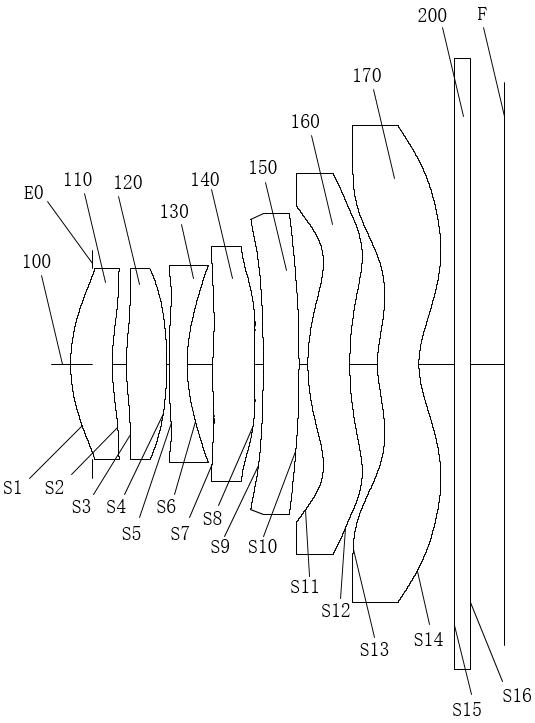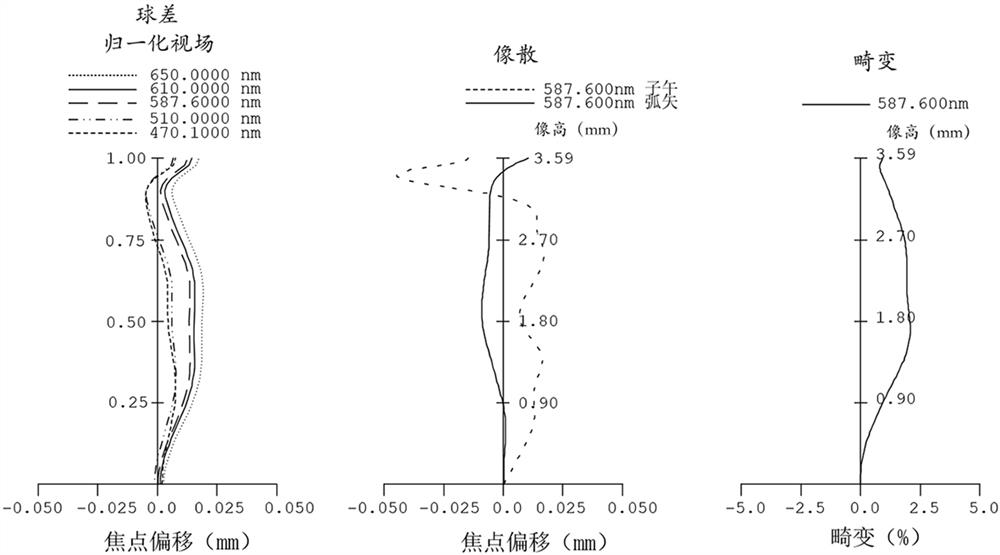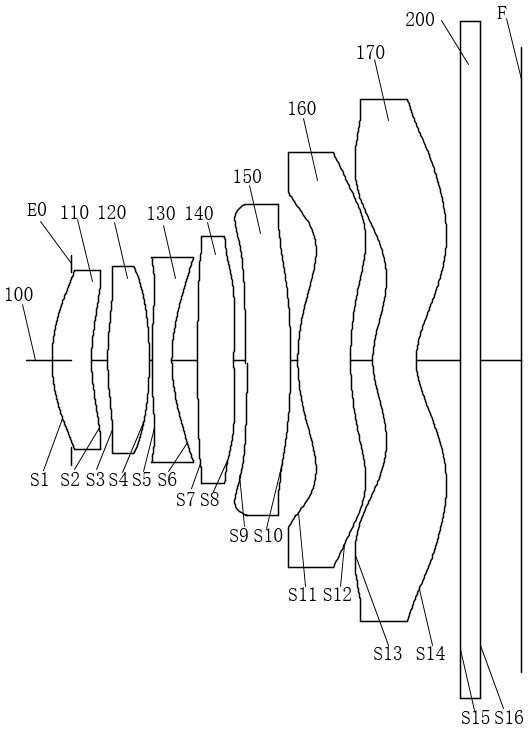Optical lens sets, camera modules and electronic equipment
A technology of optical mirrors and lenses, applied in optics, optical components, instruments, etc., can solve problems such as the limitation of the total length of the mirror group, increase the difficulty of lens design, etc., achieve the effect of improving resolution, realizing miniaturized design, and increasing degrees of freedom
- Summary
- Abstract
- Description
- Claims
- Application Information
AI Technical Summary
Problems solved by technology
Method used
Image
Examples
Embodiment 1
[0079] The structural schematic diagram of the optical lens group in this embodiment refers to figure 1 As shown, the optical lens group includes a first lens 110, a second lens 120, a third lens 130, a fourth lens 140, a fifth lens 150, a sixth lens 160, The seventh lens 170 and the infrared filter 200 , and the diaphragm E0 is disposed between the object plane of the optical lens group and the object side of the first lens 110 .
[0080]Wherein, the first lens 110 has positive refractive power. The object side of the first lens 110 is convex at the near optical axis 100 , and the image side of the first lens 110 is concave at the near optical axis 100 . The object side of the first lens 110 is convex on the circumference, and the image side of the first lens 110 is concave on the circumference.
[0081] The second lens 120 has positive refractive power. The object side of the second lens 120 is convex at the near optical axis 100 , and the image side of the second lens 12...
Embodiment 2
[0107] The structural schematic diagram of the optical lens group in this embodiment refers to image 3 As shown, the optical lens group includes a first lens 110, a second lens 120, a third lens 130, a fourth lens 140, a fifth lens 150, a sixth lens 160, The seventh lens 170 and the infrared filter 200 . And the aperture E0 is disposed between the object plane of the optical lens group and the object side surface of the first lens 110 .
[0108] Wherein, the first lens 110 has positive refractive power. The object side of the first lens 110 is convex at the near optical axis 100 , and the image side of the first lens 110 is concave at the near optical axis 100 . The object side of the first lens 110 is convex on the circumference, and the image side of the first lens 110 is concave on the circumference.
[0109] The second lens 120 has positive refractive power. The object side of the second lens 120 is convex at the near optical axis 100 , and the image side of the secon...
Embodiment 3
[0134] The structural schematic diagram of the optical lens group in this embodiment refers to Figure 5 As shown, the optical lens group includes a first lens 110, a second lens 120, a third lens 130, a fourth lens 140, a fifth lens 150, a sixth lens 160, The seventh lens 170 and the infrared filter 200 . And the aperture E0 is disposed between the object plane of the optical lens group and the object side surface of the first lens 110 .
[0135] Wherein, the first lens 110 has positive refractive power. The object side of the first lens 110 is convex at the near optical axis 100 , and the image side of the first lens 110 is concave at the near optical axis 100 . The object side of the first lens 110 is convex on the circumference, and the image side of the first lens 110 is convex on the circumference.
[0136] The second lens 120 has negative optical power. The object side of the second lens 120 is convex at the near optical axis 100 , and the image side of the second l...
PUM
 Login to View More
Login to View More Abstract
Description
Claims
Application Information
 Login to View More
Login to View More - R&D
- Intellectual Property
- Life Sciences
- Materials
- Tech Scout
- Unparalleled Data Quality
- Higher Quality Content
- 60% Fewer Hallucinations
Browse by: Latest US Patents, China's latest patents, Technical Efficacy Thesaurus, Application Domain, Technology Topic, Popular Technical Reports.
© 2025 PatSnap. All rights reserved.Legal|Privacy policy|Modern Slavery Act Transparency Statement|Sitemap|About US| Contact US: help@patsnap.com



